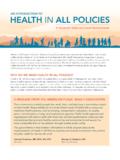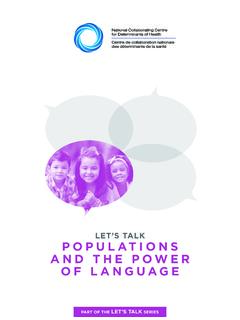Transcription of Gender Biases and Discrimination: a review of …
1 Gender Biases and discrimination : a review of health care interpersonal interactions Veloshnee Govender health Economics Unit, School of Public health , University of Cape Town, South Africa Loveday Penn-Kekana Centre for health Policy, School of Public health , University of Witwatersrand, South Africa June 2007 Background paper prepared for the Women and Gender Equity Knowledge Network of the WHO Commission on social determinants of health 1 Background to the Women and Gender Equity Knowledge Network The Women and Gender Equity Knowledge Network (WGEKN) of the WHO Commission on social determinants of health was set up to draw together the evidence base on health disparities and inequity due to Gender , on the specific problems women face in meeting the highest attainable standards of health , and on the policies and actions that can address them.
2 The work of the WGEKN was led by two organizational hubs the Indian Institute of Management Bangalore (IIMB) and the Karolinska Institute (KI) in Sweden. The 18 Members and 29 Corresponding Members of the WGEKN represent policy, civil society and academic expertise from a variety of disciplines, such as medicine, biology, sociology, epidemiology, anthropology, economics and political science, which enabled the work to draw on knowledge bases from a variety of research traditions and to identify intersectoral action for health based on experiences from different fields. Acknowledgments This paper was reviewed by at least one reviewer from within the Women and Gender Equity Knowledge Network as well as by two external reviewers. Thanks are due to these reviewers for their advice on additional sources of information, different analytical perspectives and assistance in clarifying key messages.
3 This paper was written for the Women and Gender Equity Knowledge Network established as part of the WHO Commission on the social determinants of health . The work of the network was funded by a grant from the Swedish Ministry for Foreign Affairs through the World health Organisation, the Swedish National Institute of Public health and the Foundation of Open Society Institute (Zug). The views presented in this paper are those of the author and do not necessarily represent the decisions, policy or views of IIMB, KI, WHO, Commissioners, the Women and Gender Equity Knowledge Network or the reviewers. 2 SECTION A: POLICY BRIEF Gender , either alone or in combination with other determinants of inequity profoundly influence interactions between health care providers and patients.
4 Therefore, it is important to: 1. Mainstream Gender consciousness and sensitization into the basic training and continuing education of health care providers; 2. Acknowledge the Gender context in which health workers, the majority of whom are women, live and work. By valuing, caring and respecting them, they are more likely to provide client-centred and better quality of care services; 3. Integrate Gender into health literacy programmes which intend to raise awareness and empower patient in their interactions with providers; 4. Incorporate Gender into clinical audits and other efforts to monitor quality of care; and 5. Ensuring that integration of sexual and reproductive health services does not compromise the patient-provider relationship. 3 SECTION B: EXECUTIVE SUMMARY A good interpersonal relationship between a patient and provider - as characterised by mutual respect, openness and a balance in their respective roles in decision-making is an important marker of quality of care.
5 Unfortunately however, the patient-provider interface has often been described by clients as discriminatory, marginalising, abusive and mirroring the social stratifications of society at large. This holds true for both developed and developing countries. This experience of discrimination and poor quality care is even more marked for poorer, lower class, caste women and men and is also mediated often by other factors including ethnicity, religion and language group etc. While there have been important regional and country efforts to provide more client-centred care, the special role of Gender as an underlying social determinant in shaping the interaction between clients and providers while often acknowledged is still poorly understood and only in recent years received attention.
6 In this paper, we recognise that the patient-provider interaction can be studied across a range of services including preventive, promotive, chronic, inpatient and the broad range of sexual and reproductive health services. However, for the purposes of this paper, we will focus on a limited range of conditions and services which will illustrate the important pathways Gender impacts on the patient-provider interaction. In this paper, the question will be addressed in three main parts. In the first part we are interested in mapping the context of how Gender shapes provider-client interaction, and the impact of these interactions in 4 areas: 1) differential patterns of care for men and women for the same health problem; 2) differential patterns of care by male and female health workers; 3) the gendered division of labour; and 4) patterns of abuse of patients.
7 The second part of the paper will provide a detailed breakdown of the nature of provider-patient interactions and how Gender impacts on these interactions from the perspective of patients and providers. The paper will conclude with reviewing Gender -specific policies and programme interventions within the health system for improving the interpersonal dimension of health care and hence quality of care. This paper is based on a comprehensive literature review of peer-reviewed studies and the grey literature obtained through a combination of Medline 4and web-based searches as well as links provided by colleagues working in the field of Gender and health . In order to explore the assertion of differential patterns of care for men and women for the same health problem, we looked at the experiences in the areas of tuberculosis and depression.
8 In both instances, men and women differed in a number of important ways. Not only did they understand and talk about their illnesses differently, their treatment seeking behaviour also varied. There was also evidence, from a limited number of studies that under-diagnosis of TB in women and depression in men is linked to Gender -stereotyping on the part of providers. Studies investigating Gender -based differential patterns of care by providers arise predominantly from the developed countries. The dearth of similar data from developing countries suggests an important gap in documenting the experiencing in a range of middle and low income settings. These studies, which are largely USA-based seem to suggest Gender -based differences in communication and services provided.
9 However, none of these studies have directly addressed the issue of how power is altered and shaped by the Gender dynamics between the patient and provider. For instance, are patients more passive in their interaction with male providers compared to female providers? Also, how does the interaction of Gender with class and ethnicity of the provider influence the interaction? Alternatively, are there instances where it is more important for patients to consult with providers of their own race and ethnicity and Gender is of secondary importance? In highly patriarchal societies, the importance of Gender concordance between provider and patient is important because of socio-cultural and/or religious norms and practices which not only demarcate Gender roles but also restrict social and physical contact between men and women.
10 In such societies marked by deep Gender inequities, Gender also impacts providers - particularly those at the front-line - who are predominantly women. In societies, these women experience discrimination within the workplace and the society at large, which spills over into their interaction with their patients. 5 A consideration of interventions took as its starting point the areas outlined by Women and Gender Equity Knowledge which underscores the importance of recognising that in order redress Gender - Biases and discrimination in the patient-provider interaction calls for action on multiple levels through the deployment of several strategies. The strategies we considered were in three areas: 1) health systems legislation and policy, 2) integrating Gender into health programmes, institutions and 3) integrating Gender into health worker training.


















